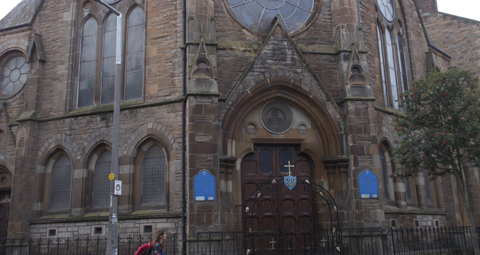September 30 | ![]() 0 COMMENTS
0 COMMENTS ![]() print
print

A growing Ukrainian Catholic community in Scotland
Scotland hosts not a single Catholic community, but many different ones. DOROTHY CUMMINGS McLEAN begins a new series on the many wonderful varieties of Scottish Catholicism with a look at the lives and worship of Ukrainians
The Catholic community in Scotland includes people from myriad cultural and liturgical backgrounds. Some belong to the Ukrainian Greek Catholic Church, others to the Syro Malabar Church. Some are members of university Catholic student unions, others have settled here from Poland. Yet others are part of the growing traditional Latin Mass community. We are going to explore the diversity of the Catholic Church in Scotland, with Sunday worship as her symbol of unity, looking first at the Ukrainians.
Our Lady of Pochaev and St Andrew in Leith is a classic 19th-century church, formerly Presbyterian, built of stone, dark and hefty, its doors guarded by gates. Walk through those doors, however, and your eyes will be dazzled by colour: the golden edges of a Madonna and Child icon contrast with the rubies and sapphires in their crowns; the ornate embroidery is bright against the white festoon over their heads; the pale blue and bright blue walls emphasise the warm tones of the wooden frame; the jewel tones of ornate Easter eggs echo those of an embroidered table cloth. And this is just the porch.
Step into the nave and you’ll wonder if you’re still in Leith. Blue walls, a high ceiling painted with golden stairs, embroidery everywhere, a miniature Byzantine church serving as a tabernacle, a vast painting of St Vladimir the Great standing before medieval Kiev: this is Ukrainian folk art in the service of the worship of God.
The roots of the Ukrainian Greek Catholic Church are spread through Ukraine, in territory once ruled by the Polish-Lithuanian Commonwealth.
St Vladimir brought Christianity to the region in 988, before the Great Schism between Rome and Constantinople. The Union of Brest, in 1596, reunited Ukrainian Orthodox hierarchy with the See of Peter. When Ukrainians were absorbed into the Austrian Empire, their rulers renamed this ‘Uniate’ church the ‘Greek Catholic’ church, to emphasise its equality with the Roman Catholic Church.
Rather less accommodating was the Russian Empire, which destroyed the Ukrainian Greek Catholic Church in the eastern territories it annexed. The church survived only in the west, in Galicia, ruled by Austria and later by Poland.
In 1945, Soviet Union leader Joseph Stalin suppressed these three remaining dioceses and demanded that Ukrainian Catholics be absorbed into the Orthodox Church. In response, the Ukrainian Catholic hierarchy went underground until the 1980s, when Soviet leader Mikhail Gorbachev introduced his policy of glasnost, or openness.
The first recorded Ukrainian in Scotland was Simon Desnytskyi, who studied at Glasgow University from 1761-67 under the tutelage of Adam Smith. He was followed in the 1770s and 1780s by a number of Ukrainians who studied medicine in Edinburgh.
However, Ukrainians did not begin to come to Britain in significant numbers until the 1890s, when they settled chiefly in Manchester.
After the Second Word War between 33,000 and 35,000 Ukrainians arrived. The first group, settled in 1946, were members of the Polish General Wladyslaw Anders’ army. The second group, shipped to Britain in 1947, were prisoners of war who had been soldiers in the Galician Division, fighting on the side of the Axis Powers led by Germany and Italy.
The third group included 21,000 Ukrainians recruited to work in vital industries under the European Volunteer Worker scheme. Their parents, spouses and children were allowed to join them.
Seven hundred Ukrainian prisoners of war were sent to Scotland, and their chapel at the Hallmuir camp near Lockerbie still exists.
These men, whose military allegiances had been primarily anti-Russian, were hired to work the land, in the pits, as bus drivers and, in Greenock, to dismantle warships.
The British centre of the Ukrainian Greek Catholic Church is London, where in 1948 Ukrainians established their first church and, in 1968, a cathedral. The Scottish heart of Ukrainian Catholicism is arguably Edinburgh and Our Lady of Pochaev and St Andrew’s Church. I went there to chat with Tomas Danelius, its young choir director, and Maria Lestiuk, a lifelong parishioner.
Edinburgh is the ‘northern base’ for the church in Britain, Maria told me. Fr Krenus, their 35-year-old priest, covers all of Scotland and northern England. The size of the Edinburgh congregation fluctuates dramatically. On ordinary Sundays it numbers about 25, but important feast days bring a crowd. “Easter is the big one,” Maria said. She and Tomas debated over whether they saw 200 or 300 people this year. “Christmas is a little less—150-ish,” Maria said.
Maria’s parents both came from Ukraine. Her father, a freed prisoner of war, arrived in 1947. After a courtship conducted by letters, his wife-to-be joined him in 1967. The couple had two children, Maria and Lydia. Our Lady of Pochaev, which the Ukrainian community bought themselves, was central to their childhood. “We were baptised here,” Maria said, reminiscing about the days when the congregation was so full of children that the parish had a Ukrainian dance troupe.
A photograph of Maria and her sister in Ukrainian traditional dress is often recycled in British news articles about Ukrainian Christmas, which falls on January 7, and the picture has become something of a joke among her family and friends.
Tomas was born in Lithuania and settled in Edinburgh four years ago. Here he met a recent Ukrainian migrant named Daria, and they married in Ukraine. Tomas encouraged his wife to go to the Ukrainian church to meet more people and was himself recruited as a choir director by the new Ukrainian priest, Fr Vasyljko ‘Basil’ Krenus, who he met at a 2013 rally in support of the Maidan anti-corruption protests in Ukraine.
No less than visual art, music is particularly important in Ukrainian liturgy as the whole Mass is sung as a dialogue between priest and people. Fr Krenus was determined that the Edinburgh parish needed its singing rejuvenated. “I didn’t conduct a choir before,” Tomas said. “Never.”
Although he went to music school in Lithuania, Tomas insists music is only a hobby. However, he set to work creating arrangements and training his choristers, including Maria, in the musical scores Fr Krenus found on the internet.
Fr Krenus, like many Ukrainian priests, is a married man. He was born in Uzghorog, Ukraine, in 1981, married his wife Vladyslava in 2008, and was ordained a priest in Croatia in 2009. The couple has a daughter named Gabriela Emilija. Fr Krenus served as a parish priest and schoolteacher in Croatia until 2013, when he came to Edinburgh. He also celebrates liturgies in Glasgow, Dundee, Galashiels and the Hallmuir chapel at Lockerbie.
The young priest seems to be a mover and shaker: when he arrived, the Edinburgh parish had an auction and raised £700 for the families of servicemen killed or wounded during the 2013-2014 Ukrainian uprising. When Fr Krenus celebrated Mass at the Hallmuir chapel, the BBC showed up to film him. Meanwhile, the parish has weekly choir meetings and an annual June pilgrimage to Carfin.
When Fr Krenus is away on holiday, the Ukrainian community goes to Mass in Latin Rite churches. “We have quite close links with the [Roman] Catholic community here,” Maria said. Their own congregation is quite mixed, as many Ukrainians in Scotland married Italian, German and Scottish women. Even members of the Ukrainian Orthodox church, recent migrants, go to Our Lady of Pochaev. Mass is said in Ukrainian with the readings, Gospel and homily all repeated in English.
The language barrier has not been a problem for the non-Ukrainians, who are used to and like it and, as Maria pointed out, ‘you always know roughly where you are.’
Both Tomas and Maria stressed that you don’t have to be Ukrainian to come to the 11am Ukrainian Catholic Mass. “Obviously the doors are open for everyone,” Tomas said.
Neither could give me a clear explanation of why so few Ukrainian Catholics in Scotland now go to church on Sundays, so I went to the Edinburgh Ukrainian Club on Royal Terrace to ask. There I found the chairperson, Linda Allison (née Antoniuk) at the close of a meeting. Linda’s father Vasyl was a Ukrainian prioner of war sent to Haddington as a farm labourer in 1947.
He married Elizabeth, a Tranent girl he met in the fields, and they had three children. Like the Lestiuk girls, Linda’s brother belonged to the Our Lady of Pochaev dance troupe.
The cellar of the Ukrainian Club is decorated with old photographs and other mementos of Ukrainian-Scottish life. One picture shows a vast gathering at Carfin. “There used to be a huge crowd,” Linda sighed.
When I asked why there no longer is, she explained that many children of the original Ukrainian community have moved away. However, she also observed that her generation grew up hearing about the family’s Ukrainian past. “Our children didn’t hear the same stories,” she said. “There are competing demands for their attention.”
Nevertheless, the participation of recent migrants suggests that the Scottish Ukrainian Catholic community will grow. Already there is one new parishioner: Tomas and Daria have recently had a baby. “We are calling him Hamish,” Tomas joked.
Ukrainian Heritage Days will be held at the Edinburgh Ukrainian Club on October 14 and 15. The choir of Our Lady of Pochaev and St Andrew’s is eagerly seeking new members.










